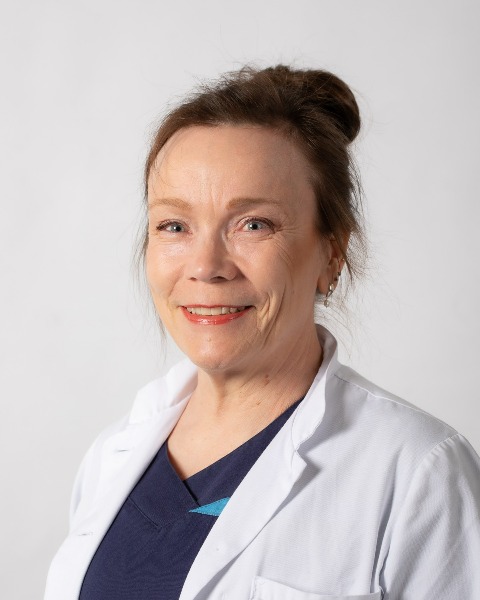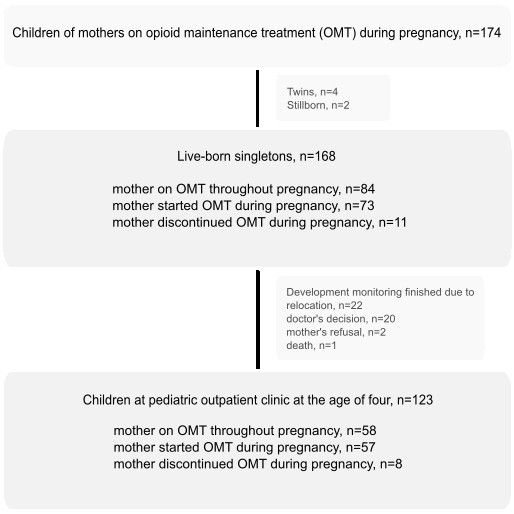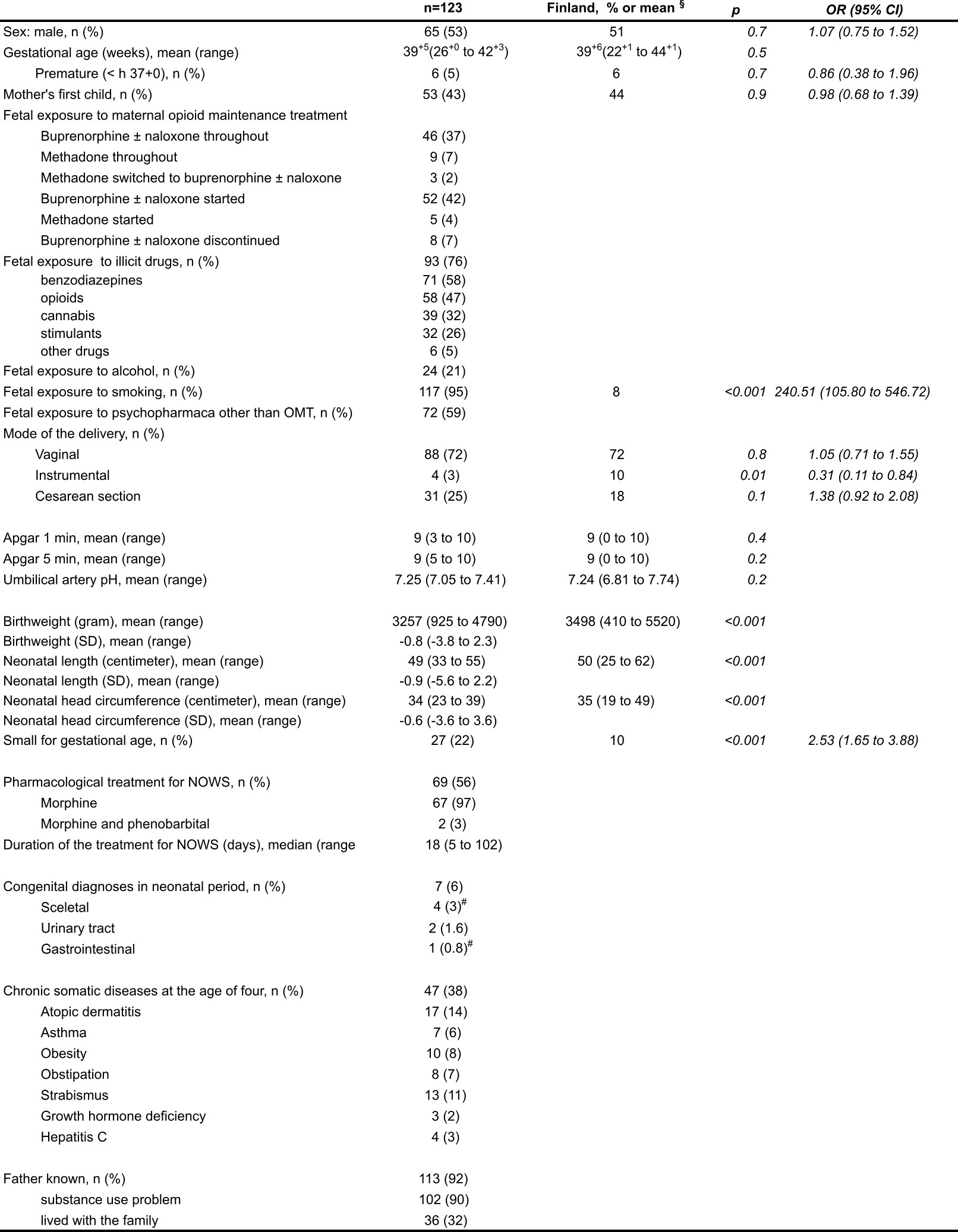Developmental and Behavioral Pediatrics 6: DBP Potpourri
Session: Developmental and Behavioral Pediatrics 6: DBP Potpourri
047 - Prenatal exposure to maternal opioid maintenance treatment contributes to developmental and behavioral difficulties at the age of four
Monday, April 28, 2025
7:00am - 9:15am HST
Publication Number: 47.6098
Minna Kanervo, University of Helsinki, Helsinki, Uusimaa, Finland; Sarimari J. Tupola, Children,s Hospital University of Helsinki, Espoo, Uusimaa, Finland; Eeva Nikkola, Helsinki University Hospital, Helsinki, Uusimaa, Finland; Mika Gissler, FINNISH INSTITUTE FOR HEALTH AND WELFARE, Helsinki, Uusimaa, Finland; Hanna Kahila, Helsinki University Hospital, Helsinki, Uusimaa, Finland; Krista Rantakari, Helsinki University Hospital, Children's Hospital, Unversity of Helsinki, Finland, Helsinki, Uusimaa, Finland

Minna Kanervo, MD PhD student (she/her/hers)
Pediatrician
University of Helsinki
Helsinki, Uusimaa, Finland
Presenting Author(s)
Background: Maternal opioid use disorder (OUD) may affect a child beyond the newborn period and lead to medical, developmental, and social challenges. However, limited evidence exists regarding the long-term effects of maternal opioid maintenance treatment (OMT) on children.
Objective: To investigate the impact of fetal exposure to maternal OMT on the child's later development and behavior. The study focused on developmental delays and diagnoses at the age of four.
Design/Methods: The study design is illustrated in Figure 1. We followed the development of 123 children at the Pediatric Outpatient Clinic of Helsinki University Hospital from birth to age four. We compared the incidence of their developmental problems with a reference group of 434 normal Finnish children of the same age.
In addition, we used ICD-10 codes to identify and compare the frequency of developmental and behavioral disorder diagnoses with hospital data from the Finnish Institute for Health and Welfare.
Results: Figure 2 presents the patient characteristics. Figure 3ab compares the prevalence of developmental difficulties between our study group and the control group, along with the frequency of diagnoses in our cohort and Finnish children of the same age.
Children in our research group exhibited significantly more developmental problems, particularly in language skills, and with difficulties across multiple areas than the control population. Males appeared to be more vulnerable to developmental delays than females.
The prevalence of speech and language developmental disorders (F80) was notably higher in our study population than among same-aged Finnish children. F80 was associated with male gender, in-utero exposure to maternal methadone OMT (p=0.004), or buprenorphine OMT exposure alongside illicit and prescribed opioids (p=0.011).
ADHD appeared to be 50 times more prevalent in the study cohort than among Finnish four-year-olds. These children were significantly more frequently from families with domestic violence (p=0.023).
Conclusion(s): Children born to mothers with OUD are at high risk for developmental and behavioral problems. Our research found no significant differences in outcomes based on maternal pharmacotherapy with buprenorphine, buprenorphine-naloxone, or methadone, except for an association between methadone treatment and speech delay.
In addition to fetal exposure, these children may encounter multiple other risk factors that can influence their development. Therefore, close monitoring and support for children exposed to illicit drugs or maternal OMT are crucial.
Fig. 1. Study flow chart.

Fig. 2. Patient characteristics.
 § Finnish Institute for Health and Welfare, Perinatal statistics 2022
§ Finnish Institute for Health and Welfare, Perinatal statistics 2022 OMT: opioid maintenance treatment
pH: potential of hydrogen; SD: standard deviation
NOWS: neonatal opioid withdrawal syndrome
#: One child with pyloric stenosis, anal stenosis, perineal groove and bilateral club finger.
Fig. 3ab. a. Developmental difficulties in LENE test# at the age of four. b. ICD10 diagnoses at the age of four
.jpg) #Lene test is a neurodevelopmental screening method, which includes age-appropriate assessments, derived from various standardized tests.
#Lene test is a neurodevelopmental screening method, which includes age-appropriate assessments, derived from various standardized tests. Reference group data for Lene test results has been randomized from normal child health clinic data from Eastern Finland (Valtonen et al. Co-occurrence of developmental delays in a screening study of 4-year-old Finnish children. Dev Med Child Neurol. 2004;46(7):436-443. doi:10.1111/j.1469-8749.2004.tb00502.x).
Reference for the ICD 10 diagnoses is from the Finnish Institute of Health and Welfare. Diagnose frequencies among Finnish four-year-old children in 2022 (n=50457).
Fig. 1. Study flow chart.

Fig. 2. Patient characteristics.
 § Finnish Institute for Health and Welfare, Perinatal statistics 2022
§ Finnish Institute for Health and Welfare, Perinatal statistics 2022 OMT: opioid maintenance treatment
pH: potential of hydrogen; SD: standard deviation
NOWS: neonatal opioid withdrawal syndrome
#: One child with pyloric stenosis, anal stenosis, perineal groove and bilateral club finger.
Fig. 3ab. a. Developmental difficulties in LENE test# at the age of four. b. ICD10 diagnoses at the age of four
.jpg) #Lene test is a neurodevelopmental screening method, which includes age-appropriate assessments, derived from various standardized tests.
#Lene test is a neurodevelopmental screening method, which includes age-appropriate assessments, derived from various standardized tests. Reference group data for Lene test results has been randomized from normal child health clinic data from Eastern Finland (Valtonen et al. Co-occurrence of developmental delays in a screening study of 4-year-old Finnish children. Dev Med Child Neurol. 2004;46(7):436-443. doi:10.1111/j.1469-8749.2004.tb00502.x).
Reference for the ICD 10 diagnoses is from the Finnish Institute of Health and Welfare. Diagnose frequencies among Finnish four-year-old children in 2022 (n=50457).

